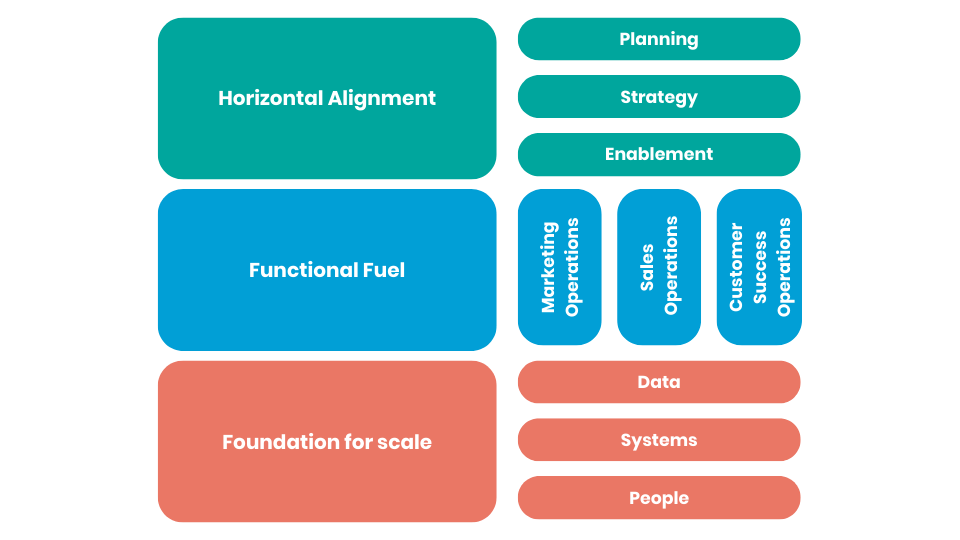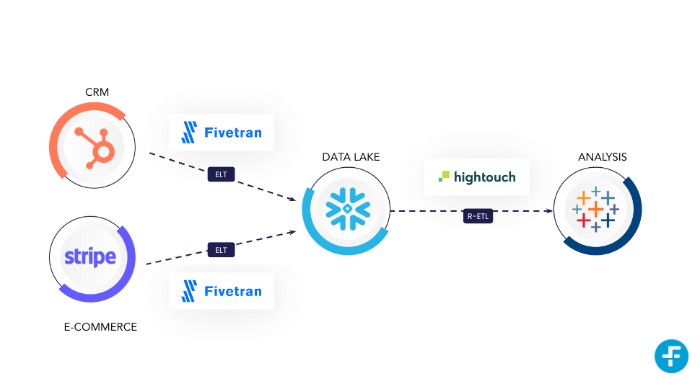


Mapping Your Data Flow for RevOps




Data is integral to any organisation's success. As a business expands and finds new heights of revenue, the size of their tech stack increases accordingly - but there may be some unseen consequences that come with this growth. When not managed carefully, data siloes can form from within individual parts of the technology systems or among certain groups in the team, which could lead to information being lost between different departments due to internal knowledge gaps.
What is RevOps?
Revenue Operations (RevOps) is a set of processes and best practices designed to accelerate business growth in an organisation. Looking at a company's internal structure, a RevOps framework puts marketing, sales, operations and customer success teams into one cohesive unit, enabling them to work together more efficiently. These teams work towards a common goal of generating revenue.
RevOps relies on a cohesive set of data and tools shared across an organisation. The resulting data-driven insights can inform strategy, streamline operations and fuel growth.
For the RevOps model to reach its full impact, companies should strongly consider adopting a modern data flow approach. When integrating critical performance metrics and customer journey mapping into Go-To-Market strategies, opportunities for greater customer lifetime value, improved retention rates, and more substantial ROI can be uncovered.

What Is The Modern Data Stack?
A modern data stack is a powerful tool for managing data effectively. It consists of various cloud-based integration tools, such as Fivetran, that allow for the transfer and transformation of data. The stack also includes secure data lake solutions, like Snowflake, and transformation providers, like Hightouch. These components form a sophisticated data infrastructure that requires fewer resources in managing data flow and enables organisations to gain deep insights into their operations.
We often see organisations adopt a modern data flow when:
- Older enterprises choose to move away from on-premise data flow tools
- Scaling companies add additional tools to their tech stack.

Data Flow Mapping for RevOps
The more systems your organisation has, the greater the likelihood for data siloes grows. For data to be mapped to align with the RevOps framework, a comprehensive understanding of the data that is being collected, stored, and analysed is required.
Data flow maps help you keep track of all the information you process. This includes why you need the information, where you store it, how you move it from one place to another, and who you give it to.
Data flow mapping for point-to-point integration.
A simple example of a data flow is mapping out the objects between HubSpot and SAP. HubSpot has a few standard objects, such as contacts, companies, deals, line items, and quotes. To successfully map these objects to SAP's objects, we also need to map out the direction of the sync. This exercise of mapping out the data flow is straightforward; by doing so, we can ensure that the integration between the two systems is smooth and seamless.
-1.png?width=900&height=985&name=Fivetran%20ELT_rETL%20ERD%20(2)-1.png)
Data flow mapping for a multiple system integration
When it comes to point-to-point integrations, it's simple enough with one or two systems. However, as your tech stack grows in size and complexity, it becomes unwieldy.
For example, we built an entity relationship diagram for a client who wanted to connect SAP and a couple of other systems. We mapped the objects and fields, established privacy, and ensured the data flowed in the right direction.
As you map multiple systems, the entity relationship diagram becomes more complicated. Not only do you have 1 to 1 mapping of fields, but you also have multiple fields and relationships between objects in different systems.
Matching fields and ensuring all data is in a cohesive format may seem simple, but it can become unwieldy when dealing with different data formats, such as an Excel file.
Monitoring and maintaining the data flow to ensure data quality and consistency
We recommend Fivetran & HubSpot to our clients to implement the data flow. An ETL approach requires little upkeep from a third party source, and ensures a high degree of security is maintained.
Once the data flow has been implemented, it's essential to monitor and maintain it to ensure data quality and consistency. This includes regularly reviewing the data to ensure that it is accurate, complete, and up-to-date. It also includes monitoring the data flow process to identify potential issues or improvement areas. By monitoring and maintaining the data flow, you can ensure that the data is accurate, consistent, and secure, and that your RevOps implementation is successful.
Six & Flow Data Services
We're here to help you with your data management, by consulting and mapping out your data. Not just the structure, but also the data primacy, cleansing and mapping the fields across multiple systems, whether it's two or ten.
Our goal is to create an Entity-Relationship Diagram (ERD) that is authentic for your business and clearly shows the data flow. This covers not just Hubspot, but also enterprise planning, invoicing, customer support and more. We will work with you to establish the primacy between all systems, ensuring data flow between your systems and data lake at the frequency you need.
We will integrate all your systems into one connected, sophisticated, secure system, ensuring all your data is in line across your platforms. This will help drive amazing customer experiences and support your business growth.








